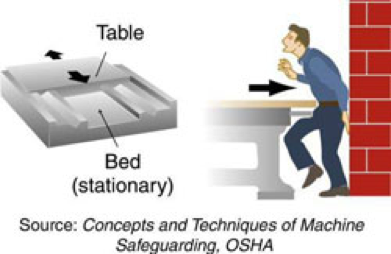March Safety Tip
 Most workers wouldn’t think of doing something as dangerous as taking a shortcut over a moving chain or assembly line or climbing up on a flimsy cardboard box. But anytime you bypass safety measures instead of using proper procedures, you risk ending up where you weren’t going, which could be to the emergency room. Moving machinery is unyielding, and in an instant you can be caught or pulled into it or suffer an amputation or crushing injury. Don’t take shortcuts when it comes to safety!
Most workers wouldn’t think of doing something as dangerous as taking a shortcut over a moving chain or assembly line or climbing up on a flimsy cardboard box. But anytime you bypass safety measures instead of using proper procedures, you risk ending up where you weren’t going, which could be to the emergency room. Moving machinery is unyielding, and in an instant you can be caught or pulled into it or suffer an amputation or crushing injury. Don’t take shortcuts when it comes to safety!
Here are some tips to prevent becoming a victim of caught-in/between accidents.
- Familiarize yourself with the hazards and potential hazards you might encounter on the job. Ask what personal protection systems will be needed for the job and make sure you have the necessary personal protective equipment (PPE). Recognize that as the work progresses, the hazards may change, and new hazards may materialize.
- Never use a piece of equipment unless all of the guards are in position and properly adjusted. Pay special attention that rotating or moving parts are properly guarded. Always realize you can get caught in machinery by belts, pulleys, gears, rotating shafts and other moving parts. Also, avoid loose clothing and other items that can be caught in machinery.
- If you’re not the one operating a piece of equipment, stay away from it. If you’re too close to a machine, you could get pinned between the equipment and a stationary object such as a wall, barrier or other piece of equipment. Also, stay out of the swing radius of equipment; the operator may not be able to see you. If you must approach a piece of equipment, make eye contact with the operator and use a clear hand signal that you are approaching his machine.
- Areas unsafe for pedestrian traffic should be barricaded. Make sure the barricade is properly maintained, and avoid walking within the designated area. If the equipment is in a stationary position, such as a crane could be, caution tape may be used to warn nearby workers of the crane’s swing area.
- When materials are moved overhead from one location to another, the possibility arises of a load being placed on a part of the body, or of the body being caught between the load and a wall or structure. Always work at a safe distance from the load and ensure you don’t come between the load and its final resting place.
